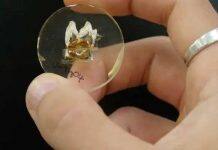An international team of experts has made a technological breakthrough for one of the most important forms of imaging: optical coherence tomography (OCT). They believe that selective collection of multiple scattered light may lead to improved image contrast at depth.


The team from the University of Adelaide, Australia, Technical University of Denmark (DTU), the University of St Andrews, Scotland and Aerospace Corp., USA, has challenged conventional wisdom which says that an OCT signal is dominated by light and has undergone a single backscattering event, whereas light scattered (scrambled) many times is detrimental to image formation.
The team discovered an alternative viewpoint – that selective collection of multiple scattered light can lead to improved image contrast at depth, particularly in highly scattering samples. Importantly they showed how this could be implemented with minimal additional optics by displacing the light delivery and collection paths.
The use of light in biomedical imaging has reached new heights in the last decade with its unprecedented combination of simplicity, ease of use to recover highly resolved image information and versatility.
“OUR STUDY BREAKS NORMS IN OPTICAL IMAGING AND I BELIEVE HERALDS A NEW PATH TO RECOVERING INFORMATION AT DEPTH. OCT IS A WORLD ESTABLISHED METHOD TO GAIN USEFUL INFORMATION ON HUMAN HEALTH – OUR APPROACH CAN ENHANCE THIS EVEN FURTHER.”
-Professor Kishan Dholakia
Spectacular advances have been made in the past few decades in retinal imaging, revolutionising applications in ophthalmology, dermatology, cardiology, and the early detection of cancer.
Yet, challenges remain, namely recovering information: scattering of light in tissue obscures information at depth.
Dr Gavrielle Untracht, Postdoctoral Researcher, DTU and first author of the paper, said: “The results of our study could be the start of a new way of thinking about OCT imaging. It’s so exciting to contribute to such a technological breakthrough in the well-established OCT field.”
Professor Kishan Dholakia from the University of Adelaide and the University of St Andrews, Scotland said: “Our study breaks norms in optical imaging and I believe heralds a new path to recovering information at depth. OCT is a world established method to gain useful information on human health – our approach can enhance this even further.”
Professor Peter Andersen, co-corresponding author, from DTU, Denmark added: “The unique configuration, supported by our modelling, should redefine our view on OCT signal formation – and we can now use this insight to extract more information and to improve diagnosis of disease.”
OCT relies on light being backscattered within a sample: this occurs when light passes between different layers of cells for example. It is similar to how light is scattered in fog: droplets of water with a different refractive index than the surrounding air scrambles your view. The scattering makes it difficult to see through the fog.
Similarly, cells (membranes and even smaller parts) in biological tissue scatter light making imaging a challenge. Obtaining a discernible signal from depths greater than 1 mm is enormously challenging due to a number of factors including signal from intervening tissue.
The team believe their breakthrough is poised to defy convention and lead to a step change in recovering images at depth. The team are further bolstered by having both granted and filed intellectual property in this area and are keen to see translation. In 2021 the OCT market was valued at US$1.3 billion and is set to triple by the end of the decade.
This cutting-edge development would not have been possible without the support of funding from the UK and EU (H2020), and the Australian Research Council (ARC) in Australia.
Mingzhou Chen, Josep Mas and Philip Wijesinghe at St Andrews, Dominik Marti at DTU, and Harold Yura at Aerospace Corp are co-authors of the work, which is published in the journal Science Advances .








































